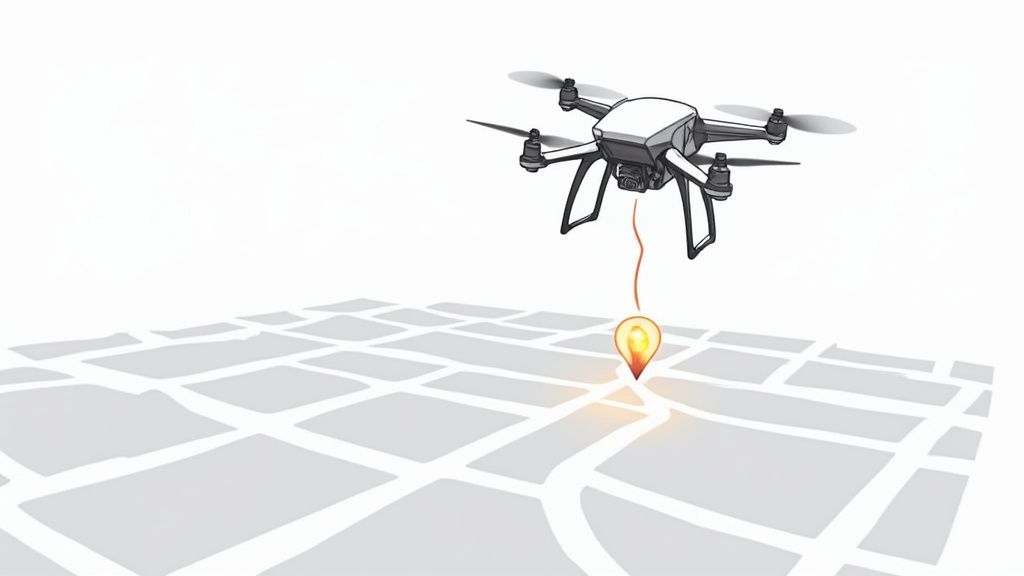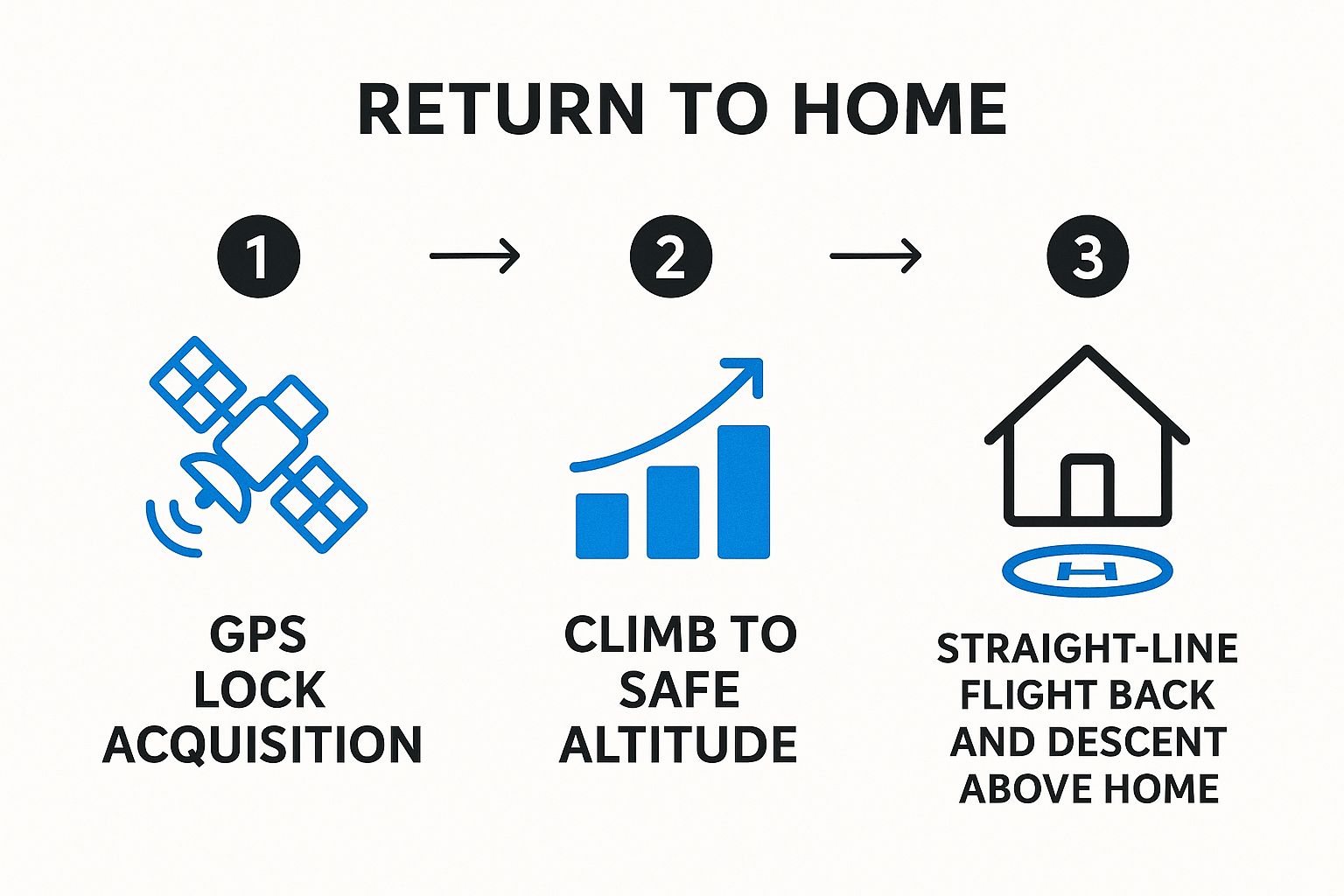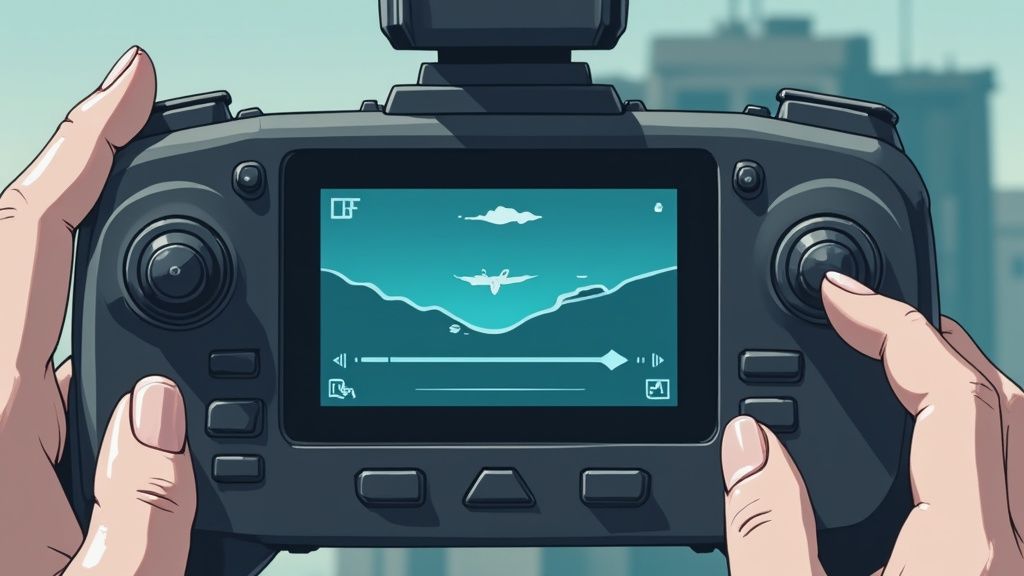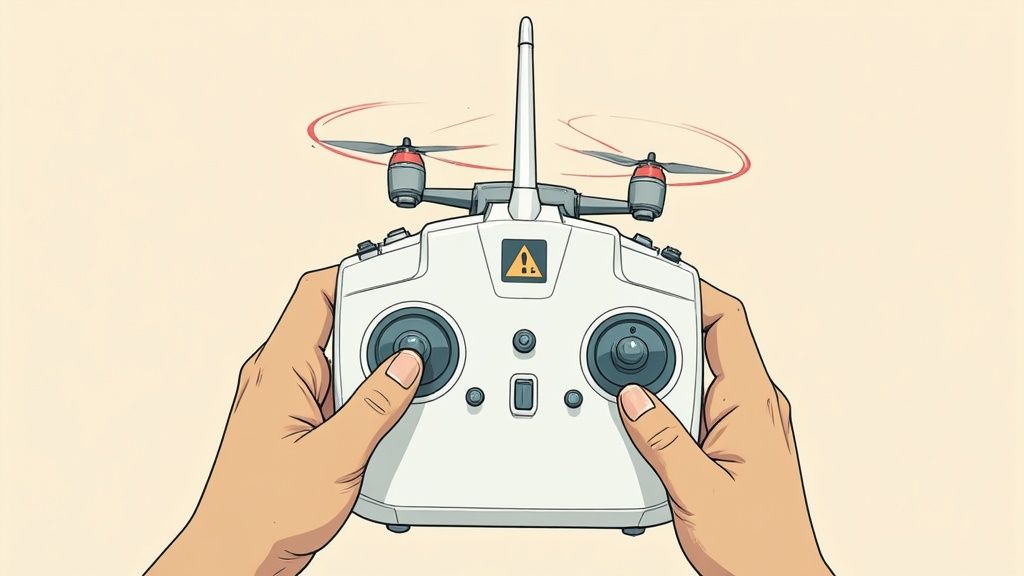Drone Return to Home: Expert Tips for Safe Flights
- A.E. Williams

- May 21, 2025
- 12 min read
Updated: May 23, 2025
Understanding the Drone Return to Home Lifeline

The Return to Home (RTH) feature is one of the most vital aspects of modern drone technology. It's a critical safety net designed to bring your drone back safely in a variety of situations. Understanding how RTH works is essential for any drone pilot, from beginners to seasoned professionals. RTH functionality has improved significantly, incorporating advancements in AI and sensor technology. The drone market, projected to reach $67.64 billion by 2029, is fueled by these innovations, including sophisticated RTH systems. China's leading role in drone manufacturing and market development underscores this technological progress. Find more detailed statistics here
RTH Triggers: Knowing When Your Drone Comes Home
Several scenarios can trigger the RTH function, ensuring your drone’s safe return. These triggers generally fall into three categories:
Manual Activation: This allows you to initiate RTH at any point by pressing a button on your remote controller. This gives you direct control in situations requiring quick action.
Low Battery: When the battery reaches a critically low level, RTH automatically activates, preventing a mid-flight power loss and a potential crash.
Signal Loss: If the connection between your drone and the controller is lost, RTH starts automatically. This is a crucial feature for long-range flights or in areas with potential interference.
These trigger types create a comprehensive safety net for your drone. For more safety tips, check out this resource: How to master drone safety and avoid hazards
To understand the different RTH triggers, let's look at the following comparison:
RTH Trigger Types Comparison A comparison of different scenarios that activate return to home functionality
Trigger Type | How It Works | When It Activates | User Configuration Options |
|---|---|---|---|
Manual Activation | Pilot initiates RTH using a dedicated button on the remote controller. | Anytime the pilot chooses. | Usually none, activation is direct. |
Low Battery | The drone's flight system monitors battery levels and automatically triggers RTH. | When the battery reaches a pre-defined critically low threshold. | Pilots can sometimes adjust the low battery threshold in the drone's settings. |
Signal Loss | The drone detects a loss of communication link with the remote controller. | When the signal strength drops below a critical level for a specific duration. | Some drones offer settings to adjust the sensitivity of signal loss detection or the time delay before RTH activation. |
This table highlights the different ways RTH can be activated, showcasing the versatility of this crucial feature. Knowing these trigger mechanisms helps pilots understand how their drones respond in various situations.
Establishing the Home Point: Where Your Drone Returns
The home point is a crucial aspect of RTH. It's the location your drone returns to when RTH activates. This point is usually automatically set as your drone's takeoff location using GPS coordinates. Most modern drones allow manual home point setting, offering flexibility to choose a safe landing spot. Some advanced systems offer dynamic home point updates, adjusting the location as you move. This ensures a safe return point, even from a moving vehicle.
The Technology Behind a Safe Return: GPS, Sensors, and Obstacle Avoidance
The RTH process uses a combination of technologies. GPS provides navigational data, letting the drone determine its position relative to the home point. Altitude sensors maintain a safe height during the return. Obstacle avoidance systems use sensors and AI to navigate around obstructions. This combined technology creates a safe and efficient return path, even in difficult environments. Some drones even use terrain data for a safe descent and landing. This sophisticated system ensures a reliable return for your drone.
The Mechanics Behind Drone Return to Home

The infographic above illustrates the three key steps involved in a drone's return-to-home (RTH) sequence: acquiring a GPS lock, ascending to a safe altitude, and navigating back to the home point before finally descending. These actions are designed to ensure a safe and efficient return. This carefully orchestrated process showcases how RTH technology integrates various systems to reliably bring your drone back home.
How Your Drone Finds Its Way Back
Activating the RTH function initiates a complex series of events within your drone. First, the drone's GPS receiver establishes a lock to pinpoint its current location. This allows it to calculate the distance and bearing to the pre-programmed home point. This location data is essential for charting the return flight path. The drone's internal compass also plays a vital role, ensuring it's oriented correctly for the return journey.
This initial positioning process forms the basis of the entire RTH procedure. With this critical starting information, the drone can then effectively plan its route back home.
Ascending to a Safe Altitude
Once the drone has determined its position and heading, it begins ascending to its pre-defined RTH altitude. This altitude is typically set higher than the drone’s current flying altitude. This is a safety precaution to avoid obstacles such as trees, buildings, or power lines. The drone utilizes its barometer to precisely measure its altitude during the climb. This is a key step in safeguarding the drone from potential collisions during its return.
After reaching the designated safe altitude, the drone commences its journey back to the home point. This upward movement helps ensure a clear path free from most environmental hazards.
Returning and Landing
Now at a safe altitude, the drone uses its calculated GPS coordinates to fly directly back to the home point. As it nears the home point, the drone begins its descent, utilizing both GPS and altitude sensors for a controlled landing. Some advanced drones even incorporate visual positioning systems. This technology allows for even greater precision, enabling accurate landings in challenging environments.
The entire return-to-home procedure is designed for maximum safety and reliability. However, factors like GPS drift, where the drone’s GPS position may shift slightly over time, and compass interference from metallic objects or magnetic fields, can impact RTH performance.
The Future of RTH
The rising popularity of drones has spurred a growing demand for dependable RTH systems. For instance, the small drone market is projected to reach $30.57 billion by 2030, demonstrating the increasing reliance on drones across various industries. Learn more about this drone market growth. This expansion emphasizes the importance of reliable RTH systems in ensuring the safe and efficient return of these aerial vehicles. Emerging features such as terrain following and enhanced precision landing represent the ongoing evolution of RTH technology, providing improved safety and performance for all drone pilots.
Setting Up Drone Return To Home For Maximum Safety

Ensuring your drone makes a safe return is paramount. The Return to Home (RTH) feature is a critical safety net, but its effectiveness relies heavily on proper setup and pre-flight checks. It's more than just activating a switch; it requires careful planning. For a more detailed pre-flight process, check out this helpful guide: How to master your pre-flight. This resource offers valuable insights into preparing your drone for a successful flight.
Calibrating For Accuracy: Compass and IMU
Before every flight, calibrating your drone's compass and IMU (Inertial Measurement Unit) is crucial. The compass acts as your drone's navigational guide, while the IMU provides its sense of balance and orientation in the air. Accurate calibration ensures a reliable RTH.
A poorly calibrated compass can send your drone off course, and an uncalibrated IMU can cause erratic flight during RTH. Most drone software provides built-in calibration procedures. Taking the time to perform these calibrations can significantly improve the accuracy and reliability of your drone's RTH function.
Strategic Home Point Selection: Avoiding Obstacles
Choosing the right home point is just as vital as calibration. Select a wide-open area, clear of obstacles like trees, buildings, or power lines. Consider the terrain and potential hazards.
Setting a home point in a confined area or near metallic structures can interfere with the drone's GPS and compass signals, potentially leading to a collision during RTH. A safe home point is key to a successful return.
Determining The Ideal RTH Altitude
The RTH altitude is the height your drone will ascend to before returning home. This height needs to clear any obstacles in its path. A general guideline is to set the RTH altitude 20-30 meters above the highest obstacle in your flight area.
However, in areas with varying terrain or tall structures, a higher RTH altitude is necessary. This provides a safe return path for your drone, minimizing the risk of collisions.
Crucial Configuration Options
Different drone models offer a range of RTH configuration options. These can include adjustable RTH speed, allowing you to prioritize speed or battery conservation during the return flight.
Some drones feature advanced options like terrain following, which helps maintain a safe altitude above the ground during RTH, especially useful in hilly areas. Understanding and utilizing these settings can significantly enhance the safety and reliability of your drone's RTH.
To illustrate the differences in RTH capabilities across various models, let's take a look at the following comparison:
RTH Configuration Parameters Across Popular Drone Models
Drone Model | Max RTH Distance | RTH Speed | Advanced Features | Limitations |
|---|---|---|---|---|
DJI Mavic 3 | 15 km | 20 m/s | Terrain Following, Obstacle Avoidance | Battery Dependent |
Autel EVO II Pro | 9 km | 15 m/s | Smart RTH, Precision Landing | Limited Obstacle Avoidance in RTH |
Parrot Anafi | 6 km | 10 m/s | Return to Start Point | Basic RTH Functionality |
This table demonstrates the variability in RTH features and performance across different drone models. Choosing the right drone for your needs and understanding its specific RTH capabilities is essential for safe and successful flights.
Troubleshooting Drone Return To Home Failures
Even with a perfectly configured drone, Return to Home (RTH) functionality can sometimes malfunction. This article explores some of the most frequent RTH issues and offers practical solutions. We'll examine real-world scenarios, from GPS interference in dense urban areas to magnetic disturbances that can throw off the compass, and even the occasional firmware issue.
For each problem, we'll provide diagnostic steps, potential fixes, and preventative measures gleaned from experienced drone pilots. We'll also discuss emergency procedures for those times when RTH fails unexpectedly, sharing recovery techniques that have saved countless drones.
Diagnosing GPS Interference
In urban settings, tall buildings can block or reflect GPS signals, creating interference and leading to inaccurate positioning. This can make RTH unreliable. For optimal safety, it's wise to incorporate your return-to-home setup with thorough UAV flight planning. This allows you to understand airspace restrictions and plan your flights accordingly.
If your drone has difficulty acquiring a strong GPS lock before takeoff, try moving to a more open area. Also, ensure your drone's firmware is current, as updates often include improvements to GPS signal processing. For instance, DJI updated their GEO system in 2025 to align with FAA Remote ID objectives.
This update impacted how drones interact with controlled airspace, illustrating the importance of software updates for reliable RTH functionality.
Addressing Compass and IMU Errors
A malfunctioning compass or Inertial Measurement Unit (IMU) can also disrupt RTH. The compass gives the drone directional information, while the IMU measures its movement and orientation. Magnetic interference from metallic objects or electronic devices can impact the compass.
Physical shocks or vibrations can affect IMU calibration. Regular calibration of both the compass and IMU is crucial for maintaining accurate RTH performance. You might also find value in learning more about drone collision avoidance.
Managing Battery and Firmware Challenges
Incorrect battery level readings can lead to premature or delayed RTH activation. Understanding your drone's battery health and performance is essential. Regular battery calibration can help maintain accurate readings.
Similarly, firmware glitches can cause various RTH problems. Keeping your drone's firmware up-to-date is vital for optimal performance and safety.
Emergency Response Procedures: When RTH Fails Completely
Even with precautions, RTH may fail. In these situations, remain calm. Try to regain visual contact with the drone. If possible, switch to manual control.
If the drone is unresponsive, activate the failsafe mode. This usually cuts power to the motors, preventing further complications and minimizing potential damage. Documenting any RTH failures, including environmental conditions and error messages, helps identify underlying issues and prevent future incidents.
Next-Gen Drone Return To Home Capabilities

The future of drone technology relies heavily on improvements in autonomous flight, especially the Return to Home (RTH) feature. This crucial function isn't simply about bringing a drone back to its starting point; it's a sophisticated process involving a network of systems working in perfect harmony. These advancements represent a significant step forward for both drone safety and reliability.
This means drone pilots can spend more time capturing breathtaking aerial footage and less time worrying about potential problems. These improvements are also making a big difference in the commercial drone industry, especially for applications like surveillance. In fact, the surveillance drone market is expected to reach $27.70 billion by 2035, driven by the increasing demand for robust security solutions. You can find more information on the expanding drone surveillance market.
Intelligent Return Path Planning
Imagine your drone not just returning home, but intelligently navigating its way back. Intelligent return path planning uses topographical data and information about no-fly zones to create the safest and most efficient route. It's like having a dedicated air traffic controller for your drone, ensuring it avoids obstacles and stays within legal airspace. This feature is especially valuable in challenging environments like mountains or areas with flight restrictions.
For those interested in learning more about the technology behind these advancements, check out this resource on how to master drone sensor technology. This guide explores the critical role sensors play in optimizing drone function.
Visual Positioning Systems: Landing With Precision
Next-generation drones can achieve centimeter-precise landings even without GPS, thanks to visual positioning systems (VPS). These systems use cameras and downward-facing sensors to create a 3D map of the landing zone. This allows the drone to accurately position itself for a smooth landing, similar to how a pilot visually confirms a landing site before touchdown. VPS is incredibly useful in environments where GPS signals are weak or unavailable, like indoors or under heavy tree cover. While drone RTH technology has significantly improved, it's not infallible. Unexpected events can happen, such as skylight damage. If you happen to encounter skylight issues, this guide offers some helpful tips for troubleshooting a leaking skylight.
Adaptive RTH Algorithms: Responding to Dynamic Conditions
Adaptive RTH algorithms use real-time flight data, including remaining battery life and distance to home, to adjust the drone's return strategy on the fly. For instance, if the battery is low, the drone might prioritize a faster, more direct route, even if it needs to fly at a lower altitude. Conversely, with ample battery, it might prioritize obstacle avoidance at a higher, safer altitude. This real-time adaptation makes RTH more reliable and efficient, much like a seasoned pilot adapting their flight plan to changing conditions.
AI and Machine Learning: Predicting and Preventing Failures
The integration of AI and machine learning is revolutionizing RTH reliability. These systems analyze flight data and environmental factors to predict potential issues and proactively adjust the drone's behavior. This predictive analysis helps prevent failures by identifying problems before they become critical. This approach, similar to preventative maintenance in aviation, provides a safer and more reliable flight experience. This proactive safety measure enhances confidence for drone users.
When Manual Control Trumps Drone Return To Home
While Drone Return to Home (RTH) is a valuable safety net, sometimes, keeping things under your own control is the best option. Relying solely on RTH can occasionally lead to trouble. This section explores critical situations where manual control is safer than automated return, offering a framework for smarter drone operation.
Obstacles Taller Than Your RTH Altitude: A Recipe for Disaster
A frequent mistake is setting the RTH altitude too low. If your drone encounters a building or tree taller than this setting during its automated return, a crash is practically guaranteed. Think about flying near skyscrapers or tall trees. Hitting RTH might send your drone directly into them. Maintaining manual control lets you steer clear of the obstacle and pick a better landing spot.
Navigating Dense Forest Canopies: Avoiding Entanglement
Flying in dense forests presents another set of challenges. RTH usually involves a vertical climb before heading back to the home point. This ascent can be risky in thick woods, where your drone could get tangled in branches. Manual control allows for a slower, more deliberate descent, navigating through openings in the canopy. This careful approach reduces the risk of damaging your drone.
Battling High Winds: When RTH Efficiency Is Compromised
Strong winds can severely impact RTH performance. Your drone might struggle to stay on course, draining the battery faster and possibly failing to reach its home point. In these conditions, manual control, combined with careful adjustments to the drone's angle and speed, often offers a better chance of landing safely. This direct intervention can be crucial when dealing with unpredictable gusts.
Practical Decision-Making During Emergencies
Developing a quick assessment strategy for emergencies is essential. When faced with a potential RTH situation, consider these factors:
Surrounding Obstacles: Are there any structures or natural obstacles that might interfere with RTH?
Environmental Conditions: What's the wind speed, visibility, and overall weather like? Could these factors impact RTH?
Drone Status: How much battery life is left? Is the signal strong? Is there any damage that might hinder the automated return?
This quick check helps you decide whether to use RTH or maintain manual control. This proactive approach is key to protecting your drone.
Alternative Emergency Procedures
If RTH isn't the best choice, consider these alternatives:
Controlled Descent: If possible, manually guide the drone down to a safe landing area. This gives you precise control over its path and landing location.
Emergency Landing: In serious situations, land the drone as quickly and safely as possible, wherever you can. This fast action might minimize damage from immediate risks.
Failsafe Mode: If your drone stops responding, activate failsafe mode, which typically cuts power to the motors. This last resort can prevent further damage or a bigger incident.
Building Critical Judgment for Safe Drone Operation
RTH is a helpful tool, but it doesn't replace skilled piloting and good judgment. Understanding RTH limitations and assessing risk makes you a safer, more capable drone operator. This deeper understanding of drone flight goes beyond automated features. It equips you to handle more situations, protecting your investment and maximizing your drone's potential.
Want to improve your drone skills and explore the newest drone tech? Visit JAB Drone for expert advice, detailed product reviews, and the latest news in unmanned aerial vehicles. Join our community of drone enthusiasts and take your aerial adventures to the next level!




Comments